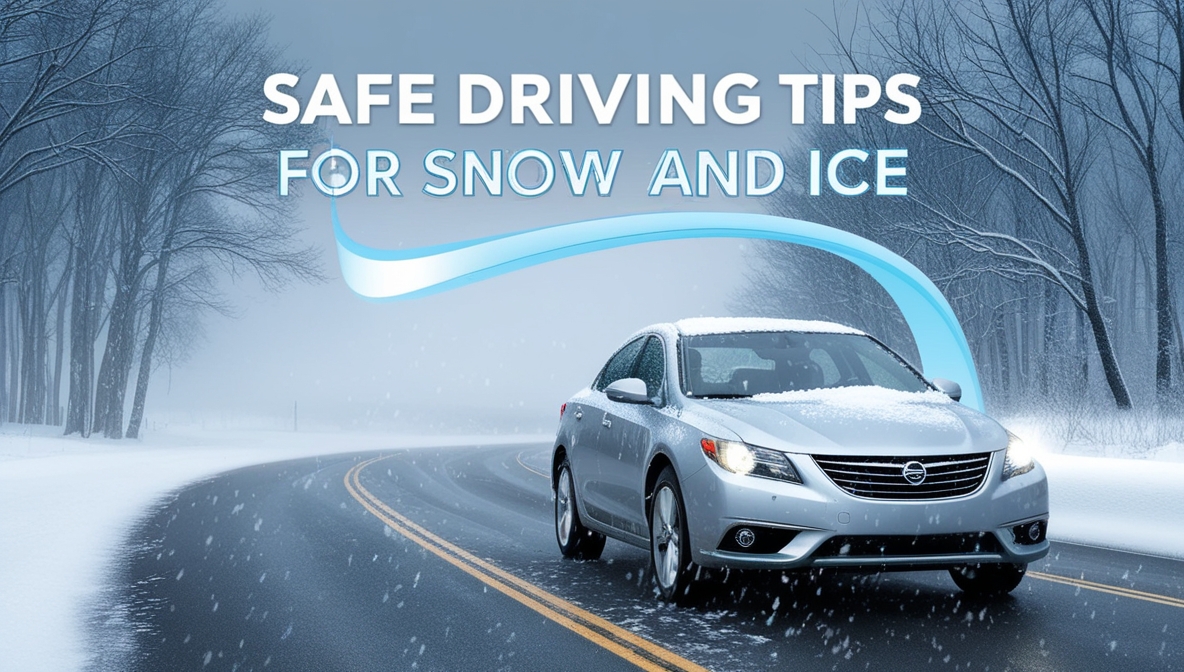As winter blankets many regions in a coat of white, driving in snow and ice becomes a common challenge for many motorists. Understanding how to navigate these slippery conditions is crucial for your safety and that of others on the road. In this blog post, we will discuss essential safe driving tips in snow and ice that will help you handle winter driving with confidence and skill.
Understanding the Hazards of Winter Driving
Before diving into our safe driving tips in snow and ice, it’s essential to comprehend the unique challenges that winter weather presents. Snow and ice can dramatically reduce visibility, affect traction, and increase stopping distances. Common hazards include:
- Black Ice: A thin layer of transparent ice that forms on the road, making it hard to see. It can occur in shaded areas, bridges, and overpasses.
- Snow Accumulation: Heavy snowfall can create poor visibility and obstruct lanes, making it difficult to maneuver.
- Reduced Traction: Snow and ice can significantly reduce tire traction, leading to skids and loss of control.
Being aware of these hazards can help you prepare mentally for winter driving conditions.
1. Prepare Your Vehicle for Winter Conditions
One of the most critical aspects of winter driving is ensuring that your vehicle is ready for the challenges it will face. Here are some safe driving tips in snow and ice that start with vehicle preparation:
Check Your Tires
Tires are your primary connection to the road. Ensure that your tires are suitable for winter conditions by:
- Installing Winter Tires: Winter tires are designed to perform better in snow and ice than all-season tires. Their unique tread patterns provide better grip and handling.
- Checking Tire Pressure: Cold weather can cause tire pressure to drop. Make sure your tires are inflated to the recommended pressure, as under-inflated tires can lead to decreased traction and increased wear.
Inspect Your Battery
Cold weather can impact battery performance. Check your battery’s health and replace it if it’s more than three years old or showing signs of weakness.
Top Off Fluids
Ensure your vehicle is equipped with winter-grade windshield washer fluid and antifreeze. This will help maintain visibility and prevent your engine from freezing.
Maintain Your Wipers and Lights
Replace worn windshield wipers and ensure that all your lights are functioning correctly. Good visibility is vital when driving in snow and ice.
2. Adjust Your Driving Behavior
Once your vehicle is ready, it’s essential to adjust your driving behavior to suit winter conditions. Here are several key strategies to employ:
Slow Down
One of the most crucial safe driving tips in snow and ice is to reduce your speed. Driving too fast for conditions can lead to loss of control, especially on icy roads. Allow for extra time to reach your destination and adjust your speed accordingly.
Increase Following Distance
In snowy or icy conditions, your vehicle will take longer to stop. Increase your following distance to at least eight to ten seconds behind the vehicle in front of you. This gives you ample time to react if the vehicle ahead suddenly stops or skids.
Use Gentle Movements
Avoid sudden accelerations, braking, or sharp turns. Make all maneuvers gradually to maintain traction and control. If you feel your tires start to slip, ease off the accelerator and steer gently in the direction you want to go.
3. Know How to Handle Skids
Skidding is one of the most common challenges drivers face in snowy and icy conditions. Knowing how to handle a skid can prevent accidents. Here’s what to do if your vehicle begins to skid:
Stay Calm
Panicking can lead to overcorrecting, which can worsen the skid. Stay calm and focus on regaining control.
Don’t Slam on the Brakes
Slamming on the brakes can cause your vehicle to skid further. Instead, ease off the accelerator and gently steer in the direction you want the front of the vehicle to go.
Countersteering
If your vehicle begins to slide sideways (oversteering), steer into the skid. For instance, if the rear of your vehicle is sliding to the right, gently turn the steering wheel to the right. This helps align your vehicle with the road.
4. Plan Your Routes
When winter weather is forecasted, it’s essential to plan your routes carefully. Here are some tips for smart route planning:
Check the Weather
Before heading out, check weather reports for any warnings or advisories. Avoid driving during severe weather conditions whenever possible.
Use Main Roads
Stick to well-traveled routes and highways that are more likely to be cleared and treated for snow and ice. Secondary roads may not be as well maintained and could present more hazards.
Inform Someone of Your Plans
If you’re traveling a long distance, inform someone of your route and expected arrival time. This way, they can check on you if necessary.
5. Carry Emergency Supplies
Being prepared for emergencies is another critical aspect of safe winter driving. Consider carrying an emergency kit in your vehicle that includes:
Basic Emergency Kit Items
- Blankets: To keep warm in case of a breakdown or if you get stuck.
- Food and Water: Non-perishable snacks and bottled water can be lifesavers if you’re stranded.
- First Aid Kit: Essential for treating minor injuries.
- Flashlight and Extra Batteries: For visibility during nighttime emergencies.
- Shovel and Ice Scraper: To clear snow and ice if you get stuck.
Roadside Assistance Kit
Consider having a roadside assistance kit that includes jumper cables, flares or reflective triangles, and a tire inflator. These can be invaluable in case of breakdowns.
6. Be Mindful of Other Drivers
In winter weather, you’re not the only one on the road facing challenges. Be considerate of other drivers and adjust your behavior accordingly:
Give Others Space
Avoid crowding other vehicles. They may need more time to stop or maneuver, and giving them space can prevent collisions.
Don’t Tailgate
Tailgating is dangerous in good weather, but it’s even more hazardous in snow and ice. Always maintain a safe distance behind the vehicle in front of you.
Use Turn Signals Early
When changing lanes or turning, use your signals well in advance. This gives other drivers time to react and helps prevent confusion on the road.
7. Stay Informed About Local Regulations
Different regions have specific laws and regulations regarding winter driving. It’s essential to be aware of any local ordinances, such as:
Snow Tire Regulations
Some areas require the use of snow tires during certain months or in specific conditions. Familiarize yourself with these regulations to avoid fines.
Road Closures
Keep informed about road closures or conditions by checking local traffic updates. Many states have websites or apps that provide real-time information on road conditions.
8. Know When to Stay Off the Road
Finally, one of the most critical safe driving tips in snow and ice is recognizing when it’s best to stay off the road altogether. If conditions are particularly severe, consider these options:
Postpone Non-Essential Trips
If the weather forecast indicates severe snow or ice, and you don’t have to be out, postpone your trip. Prioritizing your safety is always the best choice.
Utilize Public Transport
If available, consider using public transportation instead of driving. Buses and trains are often equipped to handle winter conditions better than private vehicles.
Conclusion: Navigating Winter Roads Safely
Driving in snow and ice requires preparation, awareness, and a calm approach. By following these safe driving tips in snow and ice, you can enhance your safety and the safety of those around you on the road.
Remember, the best strategy is to remain vigilant and adaptable to changing conditions. With the right mindset and preparation, you can confidently navigate winter roads and enjoy the beauty of the season while staying safe. Drive safely!




